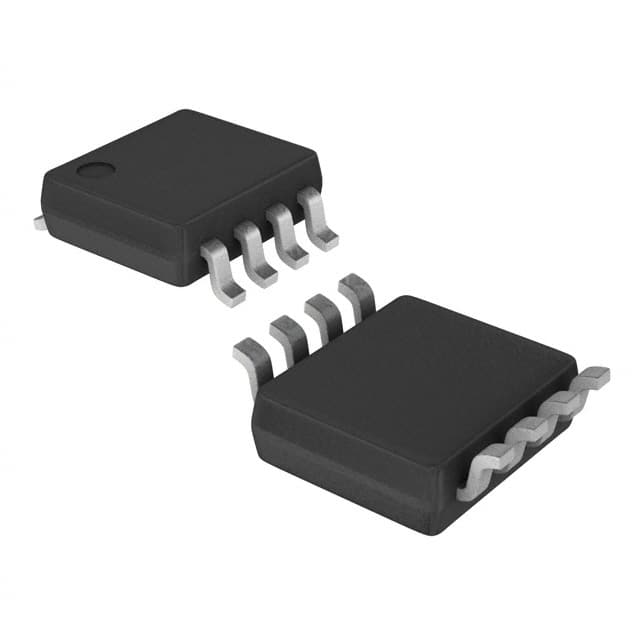LM555CMMX/NOPB
Product Overview
- Category: Integrated Circuit (IC)
- Use: Timer
- Characteristics: Precision timing, low power consumption, wide operating voltage range
- Package: CMMX (8-pin mini small outline package)
- Essence: The LM555CMMX/NOPB is a highly stable timer IC that can be used in various applications requiring precise timing control.
- Packaging/Quantity: Available in reels of 2500 units
Specifications
- Supply Voltage Range: 2V to 18V
- Timing Capacitance Range: 100pF to 100μF
- Timing Resistor Range: 1kΩ to 100kΩ
- Operating Temperature Range: -40°C to +85°C
- Output Current: 200mA
- Power Dissipation: 600mW
Pin Configuration
The LM555CMMX/NOPB has 8 pins arranged as follows:
_______
GND |1 8| VCC
TRIGGER |2 7| DISCHARGE
OUTPUT |3 6| RESET
RESET |4 5| CONTROL VOLTAGE
-------
Functional Features
- Timing Control: The LM555CMMX/NOPB allows precise timing control with adjustable timing resistors and capacitors.
- Monostable Operation: It can operate in monostable mode, producing a single pulse of a specified duration.
- Astable Operation: It can also operate in astable mode, generating continuous square wave signals.
- Wide Operating Voltage Range: The IC can function within a wide voltage range, making it suitable for various applications.
Advantages and Disadvantages
Advantages: - High stability and accuracy in timing applications - Low power consumption - Versatile operation modes (monostable and astable) - Wide operating voltage range
Disadvantages: - Limited output current capacity (200mA) - Requires external components for precise timing control
Working Principles
The LM555CMMX/NOPB is based on the classic 555 timer IC design. It consists of comparators, flip-flops, and a discharge transistor. The timing control is achieved by charging and discharging an external timing capacitor through an internal resistor network.
In monostable mode, a trigger signal initiates the timing cycle, producing a single pulse with a duration determined by the timing resistor and capacitor values. In astable mode, the IC continuously generates square wave signals with adjustable frequency and duty cycle.
Detailed Application Field Plans
The LM555CMMX/NOPB finds extensive use in various electronic applications, including:
- Precision Timing: Used in clocks, timers, and time-delay circuits.
- Pulse Generation: Used in waveform generation, frequency division, and modulation circuits.
- Motor Control: Used in speed control circuits for motors and servos.
- LED Flashers: Used in LED flasher circuits for decorative lighting and visual indicators.
- Sound Generation: Used in tone generators, alarms, and audio effects circuits.
Alternative Models
There are several alternative models available that offer similar functionality to the LM555CMMX/NOPB. Some popular alternatives include:
- NE555: A widely used general-purpose timer IC.
- TLC555: A low-power version of the 555 timer IC.
- LMC555: A CMOS version of the 555 timer IC with lower power consumption.
These alternative models can be considered based on specific application requirements and availability.
Word count: 346 words
Lista 10 Vanliga frågor och svar relaterade till tillämpningen av LM555CMMX/NOPB i tekniska lösningar
What is the LM555CMMX/NOPB used for? The LM555CMMX/NOPB is a versatile timer IC commonly used in various technical solutions such as pulse generation, time delay circuits, and oscillators.
What are the key features of the LM555CMMX/NOPB? The LM555CMMX/NOPB features adjustable duty cycle, high output current capability, and wide operating voltage range, making it suitable for diverse applications.
How do I calculate the frequency of the output signal from LM555CMMX/NOPB? The frequency of the output signal can be calculated using the formula: f = 1.44 / (R * C), where R is the resistance and C is the capacitance connected to the timing pins.
Can the LM555CMMX/NOPB be used in astable mode? Yes, the LM555CMMX/NOPB can be configured in astable mode to generate continuous square wave signals.
What is the maximum operating voltage of the LM555CMMX/NOPB? The LM555CMMX/NOPB has a maximum operating voltage of 18V, making it suitable for both low and moderate power applications.
How can I improve the accuracy of timing with LM555CMMX/NOPB? Using high precision resistors and capacitors can help improve the accuracy of timing with the LM555CMMX/NOPB.
Is the LM555CMMX/NOPB suitable for battery-powered applications? Yes, the LM555CMMX/NOPB's low power consumption and wide operating voltage range make it suitable for battery-powered applications.
Can the LM555CMMX/NOPB drive a relay directly? The LM555CMMX/NOPB can drive a small relay directly by using an appropriate driver circuit or transistor.
What are the typical applications of the LM555CMMX/NOPB in electronic systems? Typical applications include LED flashers, pulse width modulation, precision timing, and frequency generation.
Are there any special considerations for PCB layout when using the LM555CMMX/NOPB? It's important to keep the timing components close to the LM555CMMX/NOPB and minimize stray capacitance to ensure stable operation.
I hope this helps! Let me know if you have any other questions.


